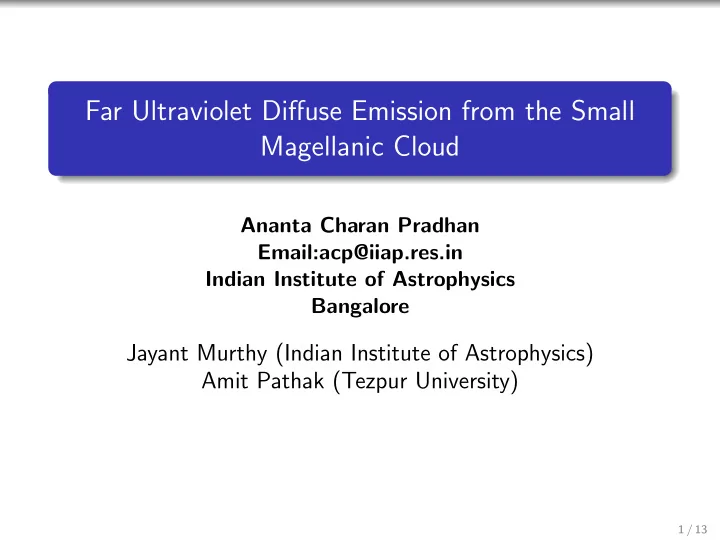

Far Ultraviolet Diffuse Emission from the Small Magellanic Cloud Ananta Charan Pradhan Email:acp@iiap.res.in Indian Institute of Astrophysics Bangalore Jayant Murthy (Indian Institute of Astrophysics) Amit Pathak (Tezpur University) 1 / 13
Introduction Ultraviolet diffuse radiation is primarily due to radiation from hot stars scattered from the interstellar dust grains. Small magellanic Cloud (SMC) is a nearby extragalactic object where dust is known to be different. Parameters Milky Way LMC SMC Distance – ≃ 50 kpc ≃ 60 kpc Metallicity Z ⊙ = 0.02 ≃ (0.3 - 0.5) Z ⊙ ≃ 0.2 Z ⊙ ≃ 1.7 × 10 − 22 ≃ 4.5 × 10 − 23 ≃ 2.2 × 10 − 23 Dust to gas ratio Extinction Average small bump No bump Oriented face on with a foreground extinction of 0.02 mag. The ISM of the SMC may be treated as primitive and can be a stepping stone to our understanding of the ISM in high redshift galaxies.
Far Ultraviolet Spectroscopic Explorer (FUSE) Segment 2B Segment 2A 4 detectors covering wavelength range from 905 - 1187 ˚ A with a high resolution of 20,000. Observations are through three apertures: LWRS (30 ′′ × 30 ′′ ), MDRS (4 ′′ × 20 ′′ ) and, HIRS (1 . 25 ′′ × 20 ′′ ). Used CalFUSE v3.2 and the data Segment 1A Segment 1B analysis of Murthy & Sahnow(2004) and obtained 30 diffuse observations out of 220.
Image of 1A Detector Bands: 1A1 (987.7 – 1020.77) and 1A2 (1035 – 1081)
Bands Used for Background Extraction λ range (˚ λ eff (˚ Sample Spectrum Det A) A) 1A1 987.70 – 1020.8 1003.93 1A2 1034.8 – 1081.4 1058.11 1B1 1100.3 – 1133.7 1117.00 1B2 1133.7 – 1180.0 1156.88 2A1 1142.0 – 1175.3 1158.65 2A2 1095.0 – 1128.6 1111.80 2B1 1035.4 – 1069.1 1056.00 2B2 981.40 – 1021.9 999.00
SMC Map & FUSE-UIT Correlation IR 160 µ m image of the SMC from Gordon et al. (2009) showing both the UIT fields and FUSE observations. FUSE-UIT Correlation We have used UIT data which has done FUV imaging survey (1300 – 1800 ˚ A: λ eff = 1615 ˚ A) Small Magellanic Cloud
Calculation of FUV diffuse fraction The diffuse fraction = diffuse/(stellar + diffuse) Total flux in a UIT field = sum of the fluxes in all pixels. Used the star catalogs (cornett et al. (1997)) to calculate the total stellar flux in each field and the diffuse flux = total flux - stellar flux. Stellar flux is extended from UIT into the FUSE using Kurucz models (Kurucz (1992)) and calculated the stellar flux in FUSE bands. Extrapolated the diffuse flux into the FUSE bands using the observed FUSE/UIT diffuse flux ratios obtained from the FUSE – UIT correlation.
FUV diffuse fraction for 1B band FUSE Field Diffuse flux Diffuse flux stellar flux DF UIT UIT FUSE FUSE FUSE NGC 330 6.73e-11 0.72 4.84E-011 2.27E-010 0.14 NGC 346 1.91e-10 0.72 1.37E-010 2.30E-010 0.32 NGC 292 4.07e-10 0.72 2.93E-010 1.76E-010 0.56 NGC 267 3.71e-10 0.72 2.67E-010 1.11E-010 0.65 Much of the stellar radiation is non-local i.e., the diffuse light is the scattered light of distant stars by local dust as it is predicted by Jura (1980) for the MW and Cole et al. 1999 & Pradhan et al. 2010) for the LMC.
Wavelength Vs Diffuse Fraction 34% at 1000 ˚ A rising upto 63% at 1615 ˚ Athat escapes the SMC Bar. It is 25% – 50% obtained from model (Witt & Gordon 2000) depending on dust geometry. Consistent with increase in value of albedo. The regional variation of (Pradhan et al. 2011, ApJ) diffuse fraction is due to Albedo and extinction cross variation of distribution of sections are from Weingartner & dust and stellar density. Draine(2001).
Wavelength Vs Diffuse Fraction for LMC Pradhan,Pathak & Murthy ApJL(2010)
Comparison of Diffuse Fraction between LMC & SMC The FUV diffuse surface brightness is patchy (as observed for the MW (Murthy & Sahnow 2004) and for the LMC (Pradhan et al. 2010) DF is 5% – 12% for the LMC & 34% – 44% for the SMC in FUSE bands.
Summary We have obtained the first observations diffuse radiation in the FUV (1000 – 1150 ˚ A) from the SMC using FUSE spectra. Most of the observations are near OB associations and are bright. Contribution of diffuse emission to the total integrated flux for the SMC is 34% to 44%, which is more than the LMC. Much light is scattered in FUV less than at longer wavelengths, suggesting that the largest part of the heating of the interstellar dust occurs in the FUV below lyman alpha. Variation of DF in different region is due to variation in distri- bution of dust and stellar density. More detailed analysis, combining the wealth of UV and IR data available into a comprehensive model of the energy flow between the stars and dust. IR studies in comparison to UV will be able to separate out the effects of local geometry from dust scattering properties.
THANK YOU
Recommend
More recommend